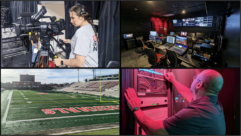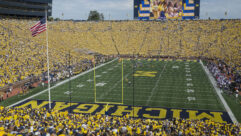
The Buzz: Installation Spotlight: Monmouth University, West Long Branch, N.J.
Mar 1, 2007 12:00 PM,
By Jessaca Gutierrez
Working the Wi-Fi

After a 120ft. FM tower in the middle of Monmouth University’s campus proved inhospitable due to its powerful transmitter, 5G’s GForce 850 b/g base stations were placed on four campus buildings to provide wireless coverage.
Wi-Fi technology has been around for years, but recently, the costs for the technology have come down, spurring a growth in the wireless arena. Suddenly college students expect not only an Ethernet connection in their dorm rooms, but unbroken wireless coverage for their laptops from the cafeteria to the quad. Although Monmouth University already provided Ethernet in almost every room of its student housing and classrooms, the university wanted to provide its students with campuswide wireless coverage in classrooms, dorms, administrative buildings, and everywhere in between.
Recently, the New Jersey university hired 5G Wireless Solutions of Marina del Ray, Calif., to cover its campus with 802.11 b/g transmitter/receivers. 5G manufactures, configures, and installs its own equipment, and for this job the company employed its G-Force 850 b/g Indoor Microcells and G-Force 850 b/g base stations. According to 5G, using this gear means less hardware can cover a larger area, due to the hardware’s unique antenna structure.
On paper, it was an easy enough installation for 5G Wireless. The company, however, had no idea that what would usually be a one-week installation would take six months.
The Wi-Fi installation was designed to cover 13 buildings and roughly 123 acres of the campus, with indoor and outdoor components. To cover the indoor spaces, 5G first had to take into consideration the buildings’ size, the number of floors, and — most importantly — the interior wall construction. Working from a design based on satellite imagery, maps of the campus, and topographical and construction information, 5G knew the first hurdle it would have to overcome for the indoor installation was the interior wall construction of the buildings. Almost every building on the Monmouth campus is made of cinder block, which is harder for RF signals to penetrate.
“Drywall interior walls are the best you can have because RF signals cut through them like a hot knife going through butter,” says Carl Weisman, vice president of engineering at 5G. “At Monmouth, we used a little more hardware than we might have normally used because of the cinder blocks.”
Working from its initial paper design, 5G installed two G-Force 850 b/g Indoor Microcells in each building, and then determined the dead spots — spots where the signal was dropped. The team then added another unit as needed to fill the dead space. Typically, two units could cover the three floors of each building, but because of the cinder block interior, each building required three units — one on each floor. “That’s still better than standard equipment. It probably would have taken nine or 12 units. It frustrates us that we had to use more hardware because of the cinder block walls. But it is what it is — every deployment is different,” Weisman says.
The cinder block interior wasn’t the only obstacle that 5G had to work around to complete the installation. For the outdoor portion of the installation, 5G deployed G-Force 850 b/g base stations, which use a cellular approach instead of a “mesh” approach to deliver wireless connectivity. A mesh approach would require multiple base stations all over campus, which would allow a laptop’s backhaul signal to jump from base station to base station until it reached the campus server. 5G says that its cellular approach uses much less hardware.
For the cellular design to be effective, though, the equipment must be placed high, such as on tall buildings. However, most of Monmouth’s buildings are two or three stories — not tall enough to transmit the signal over the 123 acres.
“But smack-dab in the middle of campus happens to be a 120ft. FM tower. Absolutely perfect,” Weisman says.
5G deployed three G-Force 850 b/g base stations on the tower. Each base station provides 120 degrees of coverage. With three base stations, they would provide 360-degree coverage — enough to cover the entire campus with outdoor wireless. The only problem was that the base stations didn’t work on the tower. The FM tower was equipped with a transmitter that delivered more than 1kW of power.
“That’s a much different frequency than Wi-Fi, so theory would dictate that it wouldn’t interfere, but the power was so high that it did,” Weisman says. “Because the deployment point was so perfect, we wanted to keep it there, so we tried all these different things. We tried metal coating of the base station using copper paint, we tried ferrites on the Cat-5 cable, we tried shielding the Cat-5, we tried everything to try to insulate our hardware from the 1kW signal.”
In the end, they gave up on using the tower and instead relied on the campus buildings. To remedy the height limitations of the buildings, 5G placed four units — adding a unit to the three that it had planned in its initial coverage design — on 10ft. to 15ft. non-penetrating roof mounts positioned on four campus buildings. Using 37 Microcell units — four outdoor and 33 indoor — placed in and on 13 buildings, 5G gave the campus full wireless coverage.
The installation made Monmouth one of the first universities on the East Coast to adopt 5G’s new cellular-style antenna design. The size of the installation was typical, but the associated challenges certainly were not. Despite the obstacles of the installation, so far 5G hasn’t heard any complaints from Monmouth.
SUBSCRIBE TO SOUND & VIDEO CONTRACTOR E-NEWSLETTERS!
Sound & Video Contractor EXTRA
Systems Integration Special Focus series:
- Houses of Worship
- Corporate AV
- Residential AV
- AV Over Fiber
- AV in Education
Breaking industry news in your email inbox every other week!
Subscribe atwww.svconline.com










